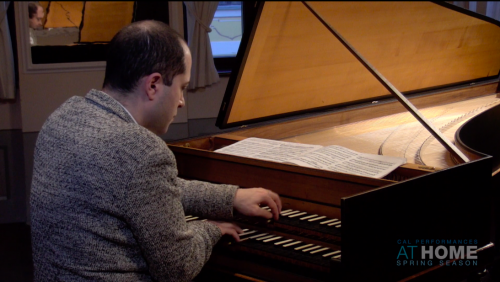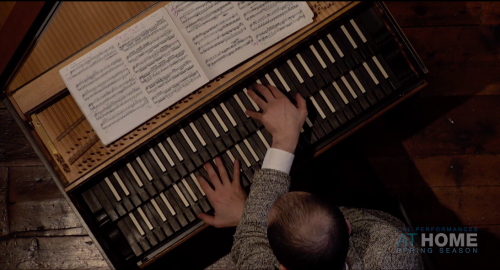 United States Bach, Goldberg Variations: Mahan Esfahani (harpsichord). Recorded 21-22 January at the Summer Hall of the Bach Archive in Leipzig, Germany, exclusively for Cal Performances at Home. Available on demand 4.3.2021 through 2.6.2021. (HS)
United States Bach, Goldberg Variations: Mahan Esfahani (harpsichord). Recorded 21-22 January at the Summer Hall of the Bach Archive in Leipzig, Germany, exclusively for Cal Performances at Home. Available on demand 4.3.2021 through 2.6.2021. (HS)

Accustomed as most of us are to hearing the Goldberg Variations played on modern pianos, it is good to be reminded why Johann Sebastian Bach’s full title for the work, published in 1741, was Aria with 30 Variations for Double-Manual Harpsichord, Goldberg Variations. It was Part IV of a collection called simply Clavier Übung (keyboard exercises). When the person reminding us is the phenomenal harpsichordist Mahan Esfahani, the results can be transcendent.
He first recorded a bold interpretation for Deutsche Grammophon in 2016, shortly after he had joined Guildhall School of Music & Drama in London as harpsichord professor. Unsurprisingly, he has refined and built upon that interpretation since, as evidenced by a performance from January caught on video exclusively for Cal Performances. Esfahani, a Persian-American who lives in Prague, performed the recital on his own harpsichord, an instrument with the requisite number of manuals and a robust sound, in Leipzig, the city where Bach wrote this work.
Esfahani has wiped the slate clean of interpretations by harpsichordists and pianists of the current era, burrowing deeply into the essence of Bach’s music and articulating it breathtakingly while offering a fresh approach to the details.
Those familiar with the hour-long Goldberg will notice that this journey begins with deceptive simplicity. The first phrases emerge without the usual embellishments, as if a voice were singing the aria. Ornamentations come later, gradually filling out the music and not always delivered exactly as we are accustomed to hearing. He seems intent on making the melodic lines spin out lyrically. Technically, it is hard to believe a plucked instrument like a harpsichord can sing, but Esfahani creates the illusion, much as a guitarist does.
The aria moves along at a stately pace but never drags. Tempos in the first few variations may feel a bit fast but, thanks to subtle tweaks to the rhythm and gentle ornamentation, they never lack for polished expressiveness. This is not Glenn Gould’s motor-driven Bach (or Wanda Landowska’s for that matter), nor does it glow with the resonance that comes from a 10-foot grand piano. It just breathes differently.
Esfahani’s approach to the nine canons is especially delicious. They punctuate the proceedings every third variation, almost like a suite scattered throughout the piece; some dance, others sing, but each one feels like a continuation of the last one heard, building in complexity even as tempos vary. Variation 15 turns contemplative before the exuberance of No.16 launches the second half. Scampering merrily through the final canon (No.27) fits itself neatly into the way Bach ratchets up the gathering storm in the final five variations.

Esfahani coaxes a range of textures from this instrument, drawing delicacy in the Andante and Adagio and springiness in the rapid tempos for others. There is much crossing of hands, too, which the video director Bernhard Fleischer captures well by interspersing overhead shots of the keyboard with more traditional angles from the side or close-ups of the player’s face.
In all this brilliance, several variations stand out: No.5 for the way the lead hand shifts from left to right without losing a thread from the texture; the Fughetta of No.10 for its impeccable clarity as the lines intertwine; No.13 for its evocation of a guitar’s sonorities. No.23, a variation that often sounds clumsy on the modern piano, feels like rain falling delicately, lifted occasionally by the wind. The fluttering right hand of No.26 is a tour de force of dexterity and deft musicality, and the constant trilling of No.28 brings thrills.
After the burst of energy in No.29, instead of making the final Quodlibet of No.30 feel majestic, Esfahani surprises us with a halting rhythm that calls to mind an improvisation, with exaggerated rubato. This leads seamlessly into the restatement of the aria, here played with more embellishment and confidence than the opening. He is unafraid to let a phrase die away or let the music take a long breath before moving on. The final phrase finishes with a sort of droop of shoulders. After the beauty of the aria, that can break a heart.
Harvey Steiman
For the performance click here.
